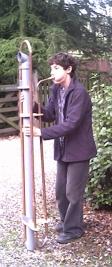
Doulophone
Encyclopedia

Ancient Greek
Ancient Greek is the stage of the Greek language in the periods spanning the times c. 9th–6th centuries BC, , c. 5th–4th centuries BC , and the c. 3rd century BC – 6th century AD of ancient Greece and the ancient world; being predated in the 2nd millennium BC by Mycenaean Greek...
word δουλος meaning slave, for the reason that the instrument is—for the most part—unable to maintain a melody of its own, and so plays a subservient role with regard to other instruments in any ensemble of which it might be participant. The alternative name "cuprophone" is derived from the classical Greek κυπρος, meaning "copper", because the majority of the instrument is constructed from said metal.
The doulophone is a lip reed or brass instrument
Brass instrument
A brass instrument is a musical instrument whose sound is produced by sympathetic vibration of air in a tubular resonator in sympathy with the vibration of the player's lips...
(invariably pitched in C), distinct in tone from the rest of the brass family and characterized by its cylindrical, wide-bore resonator
Resonator
A resonator is a device or system that exhibits resonance or resonant behavior, that is, it naturally oscillates at some frequencies, called its resonant frequencies, with greater amplitude than at others. The oscillations in a resonator can be either electromagnetic or mechanical...
(typically constructed from drainpipe). Such a resonator provides the doulophone with a rich, sonorous tone suited to its role as provider of background texture in ensemble playing. The majority of the bore is conical and "natural; that is to say, without valves or slides. This property, whiles allowing for cheap construction, unhappily precipitates a diminution of the melodic versatility of the instrument. In order to bring the useful notes of the doulophone's harmonic series into a comfortable playing range, the actual length of the instrument is required to be excessively long, providing the player with a "seismic" pedal-note that is decidedly detached from any melody that might be played on the instrument.
The doulophone was developed in 2005 by Thomas Wood, and—thus far—only three have been made: the Contrabass (with a fundamental pitch of 65Hz C), the Octocontrabass (with a fundamental pitch of 32.5Hz C, depicted above) and the Dioctocontrabass (with a fundamental pitch of 16.25Hz C). There are, however, plans to make further instruments to complete the family, from piccolo to hyperbass.

